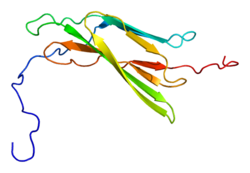MERTK
| edit |
| MER proto-onkogen, tirozinska kinaza | |||||||||||
|---|---|---|---|---|---|---|---|---|---|---|---|
 PDB prikaz baziran na 2dbj. | |||||||||||
| Dostupne strukture | |||||||||||
| 2DBJ, 2P0C, 3BPR, 3BRB, 3TCP, 4M3Q, 4MH7, 4MHA | |||||||||||
| Identifikatori | |||||||||||
| Simboli | MERTK; MER; RP38; c-mer | ||||||||||
| Vanjski ID | OMIM: 604705 MGI: 96965 HomoloGene: 4626 GeneCards: MERTK Gene | ||||||||||
| EC broj | 2.7.10.1 | ||||||||||
| |||||||||||
| Ortolozi | |||||||||||
| Vrsta | Čovek | Miš | |||||||||
| Entrez | 10461 | 17289 | |||||||||
| Ensembl | ENSG00000153208 | ENSMUSG00000014361 | |||||||||
| UniProt | Q12866 | Q60805 | |||||||||
| Ref. Sekv. (iRNK) | NM_006343 | NM_008587 | |||||||||
| Ref. Sekv. (protein) | NP_006334 | NP_032613 | |||||||||
| Lokacija (UCSC) | Chr 2: 112.66 - 112.79 Mb | Chr 2: 128.7 - 128.8 Mb | |||||||||
| PubMed pretraga | [1] | [2] | |||||||||
Proto-onkogen tirozinske proteinske kinaze MER je enzim koji je kod ljudi kodiran MERTK genom.[1][2][3]
Ovaj gen je član familije MER/AXL/TYRO3 receptorskih kinaza. On kodira transmembranksi protein sa dva domena fibronektinskog tipa III, dva Ig slična C2-tip (imunoglobulinu slična) domena, i jednim tirozinskim kinaznim domenom. Mutacije ovog gena su uzrokuju poremećaje fagocitnog puta retinalnog pigmentnog epitela (RPE) i nastup autosomalne recesivne retinitisne pigmentoze (RP).[3]
Reference
- ↑ Graham DK, Dawson TL, Mullaney DL, Snodgrass HR, Earp HS (Oct 1994). „Cloning and mRNA expression analysis of a novel human protooncogene, c-mer”. Cell Growth Differ 5 (6): 647–57. PMID 8086340.
- ↑ Weier HU, Fung J, Lersch RA (Jun 1999). „Assignment of protooncogene MERTK (a.k.a. c-mer) to human chromosome 2q14.1 by in situ hybridization”. Cytogenet Cell Genet 84 (1–2): 91–2. DOI:10.1159/000015223. PMID 10343112.
- ↑ 3,0 3,1 „Entrez Gene: MERTK c-mer proto-oncogene tyrosine kinase”.
Literatura
- Iwase T, Tanaka M, Suzuki M, et al. (1993). „Identification of protein-tyrosine kinase genes preferentially expressed in embryo stomach and gastric cancer”. Biochem. Biophys. Res. Commun. 194 (2): 698–705. DOI:10.1006/bbrc.1993.1878. PMID 7688222.
- Mark MR, Chen J, Hammonds RG, et al. (1996). „Characterization of Gas6, a member of the superfamily of G domain-containing proteins, as a ligand for Rse and Axl”. J. Biol. Chem. 271 (16): 9785–9. DOI:10.1074/jbc.271.16.9785. PMID 8621659.
- Ling L, Templeton D, Kung HJ (1996). „Identification of the major autophosphorylation sites of Nyk/Mer, an NCAM-related receptor tyrosine kinase”. J. Biol. Chem. 271 (31): 18355–62. DOI:10.1074/jbc.271.31.18355. PMID 8702477.
- Bonaldo MF, Lennon G, Soares MB (1997). „Normalization and subtraction: two approaches to facilitate gene discovery”. Genome Res. 6 (9): 791–806. DOI:10.1101/gr.6.9.791. PMID 8889548.
- Nagata K, Ohashi K, Nakano T, et al. (1997). „Identification of the product of growth arrest-specific gene 6 as a common ligand for Axl, Sky, and Mer receptor tyrosine kinases”. J. Biol. Chem. 271 (47): 30022–7. DOI:10.1074/jbc.271.47.30022. PMID 8939948.
- Georgescu MM, Kirsch KH, Shishido T, et al. (1999). „Biological effects of c-Mer receptor tyrosine kinase in hematopoietic cells depend on the Grb2 binding site in the receptor and activation of NF-kappaB”. Mol. Cell. Biol. 19 (2): 1171–81. PMC 116046. PMID 9891051.
- Gal A, Li Y, Thompson DA, et al. (2000). „Mutations in MERTK, the human orthologue of the RCS rat retinal dystrophy gene, cause retinitis pigmentosa”. Nat. Genet. 26 (3): 270–1. DOI:10.1038/81555. PMID 11062461.
- Thompson DA, McHenry CL, Li Y, et al. (2002). „Retinal dystrophy due to paternal isodisomy for chromosome 1 or chromosome 2, with homoallelism for mutations in RPE65 or MERTK, respectively”. Am. J. Hum. Genet. 70 (1): 224–9. DOI:10.1086/338455. PMC 384890. PMID 11727200.
- Strausberg RL, Feingold EA, Grouse LH, et al. (2003). „Generation and initial analysis of more than 15,000 full-length human and mouse cDNA sequences”. Proc. Natl. Acad. Sci. U.S.A. 99 (26): 16899–903. DOI:10.1073/pnas.242603899. PMC 139241. PMID 12477932.
- Yin JL, Hambly BD, Bao SS, et al. (2004). „Expression of growth arrest-specific gene 6 and its receptors in dysfunctional human renal allografts”. Transpl. Int. 16 (9): 681–8. DOI:10.1007/s00147-003-0593-3. PMID 12768229.
- McHenry CL, Liu Y, Feng W, et al. (2004). „MERTK arginine-844-cysteine in a patient with severe rod-cone dystrophy: loss of mutant protein function in transfected cells”. Invest. Ophthalmol. Vis. Sci. 45 (5): 1456–63. DOI:10.1167/iovs.03-0909. PMID 15111602.
- Chen C, Li Q, Darrow AL, et al. (2004). „Mer receptor tyrosine kinase signaling participates in platelet function”. Arterioscler. Thromb. Vasc. Biol. 24 (6): 1118–23. DOI:10.1161/01.ATV.0000130662.30537.08. PMID 15130911.
- Brandenberger R, Wei H, Zhang S, et al. (2005). „Transcriptome characterization elucidates signaling networks that control human ES cell growth and differentiation”. Nat. Biotechnol. 22 (6): 707–16. DOI:10.1038/nbt971. PMID 15146197.
- Li Y, Mahajan NP, Webster-Cyriaque J, et al. (2004). „The C-mer gene is induced by Epstein-Barr virus immediate-early protein BRLF1”. J. Virol. 78 (21): 11778–85. DOI:10.1128/JVI.78.21.11778-11785.2004. PMC 523243. PMID 15479819.
- Gould WR, Baxi SM, Schroeder R, et al. (2005). „Gas6 receptors Axl, Sky and Mer enhance platelet activation and regulate thrombotic responses”. J. Thromb. Haemost. 3 (4): 733–41. DOI:10.1111/j.1538-7836.2005.01186.x. PMID 15733062.
- Liu T, Qian WJ, Gritsenko MA, et al. (2006). „Human plasma N-glycoproteome analysis by immunoaffinity subtraction, hydrazide chemistry, and mass spectrometry”. J. Proteome Res. 4 (6): 2070–80. DOI:10.1021/pr0502065. PMC 1850943. PMID 16335952.
- Graham DK, Salzberg DB, Kurtzberg J, et al. (2006). „Ectopic expression of the proto-oncogene Mer in pediatric T-cell acute lymphoblastic leukemia”. Clin. Cancer Res. 12 (9): 2662–9. DOI:10.1158/1078-0432.CCR-05-2208. PMID 16675557.
- Tada A, Wada Y, Sato H, et al. (2006). „Screening of the MERTK gene for mutations in Japanese patients with autosomal recessive retinitis pigmentosa”. Mol. Vis. 12: 441–4. PMID 16710167.
Vanjske veze
- GeneReviews/NCBI/NIH/UW entry on Retinitis Pigmentosa Overview
- p
- r
- u
PDB Galerija
|








